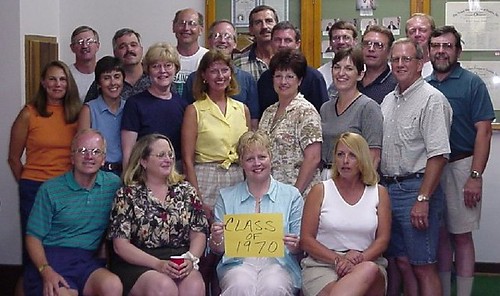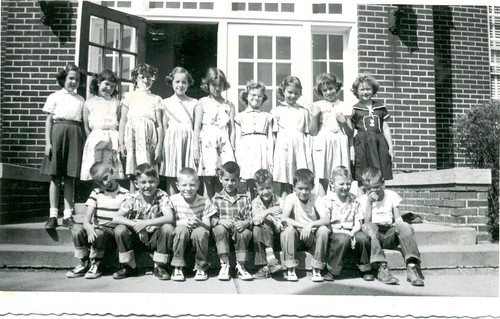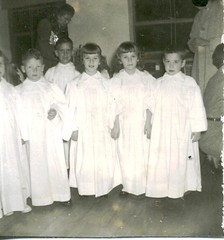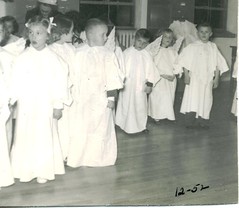The movie Doubt premiered in October 2008, but I watched it for the first time a couple of weeks ago. The movie's story takes place in a Roman Catholic parochial school in about December 1964 and focuses on the eighth-grade class that graduated in 1965. Since I was a student in the eighth-grade class that graduated from a parochial school in 1966, I watched the movie with attention toward similarities from my own experience.
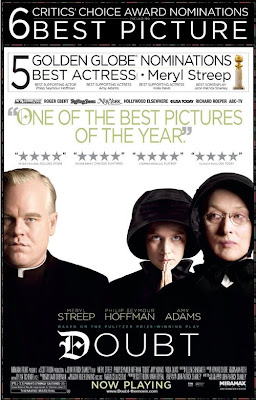
The story includes a mention that the assassination of President Kennnedy (November 22, 1963) had happened in the previous year and includes some mentions that the school now was preparing for its annual Christmas pageant, so the story takes place in about December 1964.
I noticed some details of the story, set, props and costumes that reminded me of my own experiences at St John. There were a few scenes showing the students preparing for the Christmas pageant. The classrooms, desks, school books and various items were familiar to me from that time. There is a scene where the boys are practicing basketball, and the gym shorts looked like what we wore at St. John.
Since the faculty of the school in the movie were Roman Catholic priests and nuns, their clothing and celibacy made them different from St John's faculty in obvious ways, but I perceived that both faculties were devoted similarly to religious education of children.
On a higher level, I perceived that the movie dealt with the experience of doubt, which is an important concept in religion and perhaps especially in the Christian religion as it was taught to me. Doubts about one's religion are a natural and common experience, but they are suppressed and so cause private anxiety.
I thought that Doubt was a superb movie. This essay reveals the entire plot, including the surprise ending, but I do not think that reading this essay would spoil the experience of watching the movie for the first time afterwards.
Several critics placed Doubt in their lists of the best ten movies of 2008.
James Berardinelli, ReelViews - 2nd best
Joe Neumaier, New York Daily News - 2nd best
Kyle Smith, New York Post - 8th best
Peter Travers, Rolling Stone - 8th best
David Edelstein, New York - 9th best
Michael Rechtshaffen, The Hollywood Reporter - 10th best
Shawn Levy, The Oregonian - 10th best
All four of the movie's main actors were nominated for Academy Awards:
Meryl Streep for Best Actress
Philip Seymour Hoffman for Best Supporting Actor
Amy Adams for Best Supporting Actress
Viola Davis also for Best Supporting Actress
Also, the screenplay writer John Patrick Shanley was nominated for Best Adapted Screenplay. None of those actors receive an Oscar for this film, but the Critics Choice Award contest gave its award for Best Actress to Meryl Streep.
The movie depicts a situation where a Roman Catholic priest is suspected of sexually molesting a boy, but the movie is not anti-Christian or anti-Catholic. All the characters are intelligent, admirable people, whose religious beliefs and motivations are depicted in a respectful manner.
The Plot
The movie takes place in a Roman Catholic parochial school in The Bronx, New York, in the year 1964 and focuses on the eighth-grade class, which is taught by a young nun, Sister James (Amy Adams). The school's principal is an old nun, Sister Aloysius (Meryl Streep), who is subordinate to the parish's young priest, Father Flynn (Philip Seymour Hoffman).
Practically all the school's students are of Irish or Italian ancestry. During the middle of this school year, however, an African-American boy, Donald Miller, joins the eighth-grade class and becomes the first such child to attend the school.
In addition to being African-American, Donald is also homosexual. The movie does not show him to be effeminate, but his mother Mrs. Miller (Viola Davis) eventually tells Sister Aloysius that she had transfered Donald to the Catholic school from a public school where he had been beaten frequently -- mostly by other African-American students -- because they perceived that he was homosexual. At home, Donald is frequently beaten by his own father for the same reason.
Father Flynn gives special attention and friendship to Donald and makes him an altar boy. Donald admires Father Flynn and tells him he would like to become a priest. Sister Aloysius notices this close relationship and suspects that Father Flynn is seducing Donald.
One day while Sister James is teaching her eighth-grade class, she receives a note telling her to send Donald immediately from the class to the office of Father Flynn. When Donald returns to the class, he seems to be upset, and Sister James smells alcohol on Donald's breath. Sister James reports this incident to Sister Aloysius.
Sister Aloysius invites Sister James and Father Flynn into her office to confront Father Flynn about his relationship with Donald. At first Father Flynn refuses to discuss the matter with the two nuns, but eventually he explains that the janitor Mr. McGinn had caught Donald drinking Communion wine and reported the offense to Father Flynn. Therefore Father Flynn had called Donald out of class in order question and reprimand him. According to Father Flynn, Donald confessed to drinking the wine, but Father Flynn decided to forgive Donald and remain silent about the offense, so that Donald could continue to serve as an altar boy. Since the two nuns had compelled Father Flynn to tell this incident, however, Donald now would have to be removed from the position of altar boy.
Sister Aloysius does not accept Father Flynn's explanation. She still suspects that Father Flynn called Donald out of class in order to give him some alcohol to drink and to molest him. Father Flynn challenges Sister Aloysius to question Mr. McGinn and thus to confirm the truth of Father Flynn's account.
Father Flynn leaves Sister Aloysius' office, and Sister Aloysius and Sister James talk some more. Sister James says she believes Father Flynn's explanation. Sister Aloysius indicates that it would not be worthwhile to question Mr. McGinn, because she would not believe him either. Sister Aloysius says she is certain that Father Flynn is molesting Donald and that she intends to get rid of him from the parish and school.
Sister Aloysius invites Mrs. Miller to her office, and Mrs. Miller explains that she realizes that Donald is homosexual. Mrs. Miller does not care much that Father Flynn might be sexually molesting Donald. She is grateful that at least Father Flynn is being nice to Donald. She figures that if Donald graduates from this school's eighth grade, then he can get into a good high school and then later get into a good college.
The hostility betwen Sister Aloysius and Father Flynn grows, and eventually they meet again in Sister Aloysius' office to argue about the situation. She tells him that she phoned a nun in the previous parish where he had served as a priest, and the other nun had informed her that he had been compelled to leave that parish because of some sexual misbehavior. He denies this accusation, but he avoids answering several direct questions that Sister Aloysius asks. He says that everyone has sinned, but he does not specify any sins that he committed in this regard.
Although Father Flynn continues to deny that he molested Donald, he himself asks his church superiors to remove him from his assignment in the parish and school. He tells his congregation that he is departing to a new assignment, and then he does depart immediately.
Afterwards, Sister Aloysius and Sister James have a conversation in which Sister James says that she still believes Father Flynn's explanation completely and believes that he was innocent in the matter. Sister Aloysius admits that she had not really phoned any nun at Father Flynn's previous parish. She had made up that story, but she considered Father Flynn's immediate resignation from the parish to be proof that he indeed did have a history of homosexual molestation.
Then in a suprise ending, Sister Aloysius breaks down and weeps and admits that she has doubts about the matter.
The movie's plot is described in much more detail on this webpage and on this webpage.
The Meaning
Father Flynn's evasive answers in his last argument with Sister Aloysius and his immediate resignation indicated to me that he indeed did have a history of molesting male students. I think, though, that he was trying to control himself in this parish and that he had not molested Donald. Father Flynn's experiences with his own homosexuality had given him a special sympathy for Donald, and so he sincerely wanted to protect and help Donald and did not intend to seduce him.
The mystery of whether or not Father Flynn had sexually molested Donald was not, however, the major question that the movie raised for the viewers. Rather, the major question is how anyone should deal with a situation in which he doubts that he is following a proper path in life.
At the beginning of the movie, Father Flynn gives a sermon to his congregation about that very theme. He points out that in the previous year President Kennedy had been assassinated, and afterwards the entire population of our country shared common doubts about whether we were following a proper path. Father Flynn then contrasted that feeling of a shared doubt with the feeling that an individual feels when he is suffering severe problems and thinks he might be following a wrong path in life. Father Flynn ends his sermon by reassuring his congregation that in those situations of individual doubt, they never are really alone. He implies that such doubts are shared by other people and also that God accompanies and is available to every individual in such a situation.
If Father Flynn did have a history of homosexual misbehavior in his previous church assignments, then he was aware that his special relationship with Donald might lead to trouble. On one hand he intended to help Donald, but on the other hand he might become involved in a sexual relationship with the boy.
Then when Father Flynn was confronted and accused by Sister Aloysius, he had to decide whether to continue to dispute her accusations, which still were false, or to give up and quit the parish and the school. He felt that if he stayed, then he could modernize the school over the old-fashioned, strict discipline and mindless, arbitrary rules that were imposed by Sister Aloysius. On the other hand, he feared that if he continued to resist the accusations of Sister Aloysius, then he as a modernizing priest eventually would be discredited in an embarrassing scandal. In the end, he decided to leave this assignment so that he could try anew in a different assignment.
These were decisions that Father Flynn had to make alone. Perhaps he confessed to and consulted with his superior priest, but ultimately he himself decided first to develop a close relationship with Donald and then to quit the parish and the school. Father Flynn essentially was alone in this doubt and in his decisions.
Likewise, Sister Aloysius was alone in her doubt and decisions. Early in the movie, she remarked that in previous years the church had a senior priest who had dealt with a similar situation where a junior priest was molesting students. Now, however, the nuns themseves had to deal with this situation, and she was the only nun with the insight, experience and personality who was capable of dealing with the situation.
I was surprised at the end when she broke down and wept under the strain of dealing with her own doubt about the situation. This seemed to end the movie with a false note, but afterwards as I thought about it, I felt a richer appreciation of her personal mental and spiritual struggles with the situation.
Likewise, Sister James was alone in her doubts and decisions. She admired Father Flynn, and it surely was a very difficult for her to report her suspicions to Sister Aloysius. Then, as she changed her mind to thinking that he was innocent, she had to deal with the disapproval and contempt of Sister Aloysius and with the resentment of Father Flynn.
Likewise, Mrs. Miller was alone in her doubts and decisions. Her husband added to her difficulties in dealing with the problems caused by her son Donald's homosexuality. Her husband beat and rejected Donald, so she alone made the decisions and efforts to help her son try to succeed in life.
These four characters each struggled alone with their doubts and decisions. Their paths crossed in this situation, but there was practically no helpful cooperation among them, and their was no happy ending for any of them.
Nevertheless, each of them found the inner resolve to make important, thoughtful decisions and to accept the consequences.
Father Flynn had ended his sermon by reminding his congregation that when they as individuals suffered through doubtful situations, they were not alone. He did not mean, though, that they always would receive advice and help from other people or even from God. He meant only that they were not alone in such suffering, because we all suffer through such situations. We always should appreciate at least that consolation.
--------
In a religious context, the concept of doubt usually applies to doubt about the religion itself. The person doubts that God exists or doubts that God is good or doubts that his religion is true.
That kind of doubt did not appear in this movie. None of the characters expressed any doubts about their religious beliefs.
However, people who are suffering profound doubts about their religion probably will relate the movie to that concern. When Father Flynn preaches that each of us suffers doubts individually that we are on a proper path, many viewers of the movie will think about their own doubts that they are wasting their lives on a religion that might be foolish and false. Father Flynn's assurance, at the beginning of the movie, that they are not alone in such individual doubts should engage them in the further story of the movie.
For those viewers who are suffering severe doubts about their religion, I think that the movie at least gives a good impression about people who have committed themselves to very religious lives. All the characters have admirable qualities and deal with their problems in an intelligent manner. They all are comfortable in their religious lives. They all are striving to raise children to become religious adults. The movie brings the viewers into the lives of these religious people and develops the viewers' sympathies toward them.

